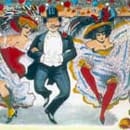We expected champagne. Instead, we were served sparkling wine. Perhaps even kid-friendly fizzy drink! During the premiere on December 26th of Jacques Offenbach’s “La Vie Parisienne” at the Nice Opera, a sort of mixing of genres took place. It’s hard to blame them fully, as it’s become quite unclear which category this staple of entertaining music really belongs to. Caught between “opéra comique” and “opéra-bouffe”, it’s uncertain whether the performers, musicians, and even the audience can really find their footing. Created in 1866 on the eve of the world’s fair, intended to welcome, in the words of Alphonse Daudet, “fleets of nabobs,” “La Vie Parisienne” indeed borrows from both registers: a mix of “sung and spoken in French,” characteristic of the opéra comique as precisely codified by a decree from Napoleon; yet it also closely resembles the Italian opera buffa in its focus on the “common people” and a mode meant to relax within the pure tradition of comic intermezzos inserted into opera seria (the “serious” opera). These subtle distinctions were abandoned by the end of the 19th century, also allowing operetta to make its entrance and adding to the confusion of the musical lexicon. A delicate balance thus needed to be found among all these options. According to a statement attributed to Camille Saint-Saëns, “operetta is a wayward daughter of the opéra-comique, but wayward girls are not always without their charms.” Something to see.
The Nice Opera had, it seems, chosen the “long version,” the five-act one, cut down to four in the 1873 version presented at the Théâtre des Variétés. Still, maintaining the pace was crucial to avoid the dreaded boredom of endless spoken exposition scenes reminiscent of “au théâtre ce soir”. Despite his youth and brilliance, conductor Benjamin Pionnier probably lacked the necessary edginess to direct a score that demands ardor, biting attacks, and lively rhythm. In short, something sparkling.
The playful ambiance of the overture that led the artists into the bustling movement of this “Gare de l’Ouest” at the beginning of the piece did give a sense of a good start. Unfortunately, this soon gave way to a sort of scenic breakdown and musical lethargy. Despite Nadine Truffaut’s efforts to create dynamics with the moving circularity of the stage and the continuous symbolism of the clock, the interpretations as exhilarating as they were lyrically pleasant by Giselle Blanchard, and the multiple ones by Gilles Ragon, an imperturbable comic even when, within a few minutes, without mixing up accents, he switched roles from a German shoemaker to a wealthy Brazilian, brought much-needed oxygen to the whole: both together (in the “glover and the shoemaker”) and separately, they performed energetically, flirted delicately, expressed themselves clearly, and sang enthusiastically. “What more could you ask for?” as Bobinet pitched to the discontented but ultimately happy Baron de Gondremark from being swindled yet pleased with his Parisian stay. Similarly, despite his debut in this role, the brilliant, last-minute performance by Eric Martin-Bonnet as said Baron, endowed with a fine bass voice adjusted for the occasion, and commendable efforts in diction in the spoken parts, also made him stand out.
“La Vie Parisienne” offers several readings. Indeed, Jacques Offenbach, if one dares say, muddied the waters. Respecting the tradition of the opéra comique, a “jest that parodies the grand opera in an ironic and political mode” according to Maryvonne de Saint-Pulgent, President of the Opéra Comique, the work of the German-born composer develops scathing criticism of the Napoleon III era. The hypocrisy of polite society, the permissiveness of morals behind a façade of strict propriety, the reign of money – “Paris is a charming place for people who are comfortable,” as heard upon the Brazilian’s arrival – are skillfully denounced. In this plethora of false aristocrats and commoners craving high society women, one can sense the atmosphere of the “world’s customs” stated by the “false” Baroness Staffe, alias Blanche Soyer whose 1891 best-seller did not have fewer than 347 editions since its release (Baroness Staffe, “Usages du monde, rules of etiquette in modern society”, coll. Texto, Editions Tallandier, 2007).
As described by the Baroness and set to music by Jacques Offenbach, this “La Vie Parisienne” from the Nice Opera ends in a bluster: in the final moments just before the curtain falls, the audience, pulled from its relative lethargy by a frenetic French Cancan, albeit anachronistic as noted by Dominque Ghesquière, an expert in opéra-bouffe, in the opera’s program booklet. With shrill, hysterical screams capable of awakening the dead


